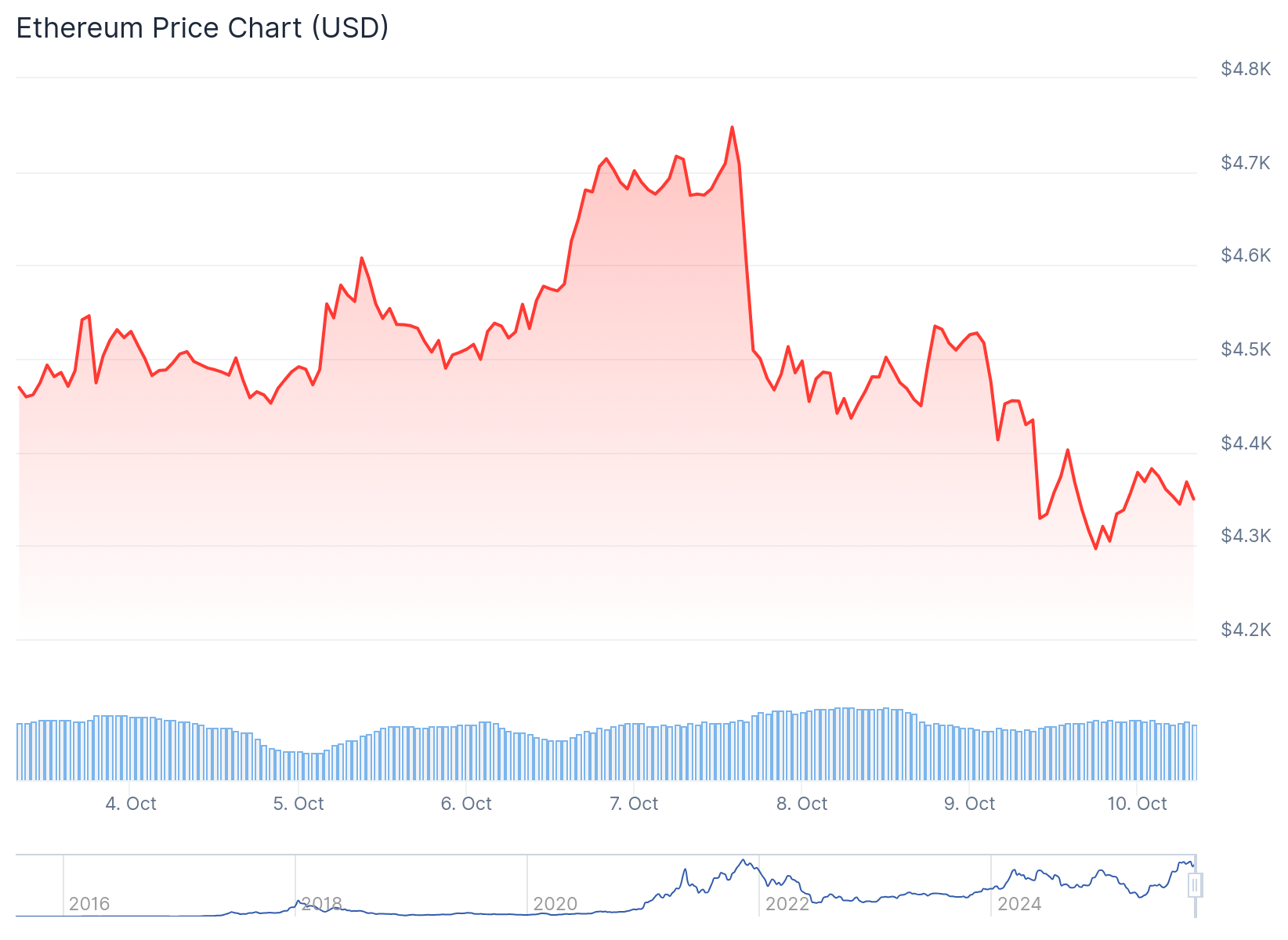TLDR
- Ethereum’s internal contract calls jumped 35% to 9.5 million daily, indicating strong network growth and ecosystem activity
- Tokenized real-world assets on Ethereum surged 680% to $11.7 billion, with BlackRock’s BUIDL fund holding $2.4 billion
- Grayscale staked $5.14 billion worth of ETH, showing major institutional commitment to the network
- ETH trades at $4,376 with support expected between $4,100-$4,250 and potential resistance at $4,800
- Technical indicators suggest possible short-term weakness but analysts maintain $10,000 price targets
Ethereum’s network fundamentals continue to strengthen even as the price faces short-term pressure. ETH is currently trading at $4,376 with a market cap of $528.26 billion after declining 2.58% in the last 24 hours.

Data from CryptoQuant reveals Ethereum’s internal contract calls have climbed to 9.5 million per day. This marks a 35% jump from the previous 7 million daily average. The metric tracks complex network interactions including DeFi protocols and real-world asset tokenization.
The increase started in mid-July and has held steady since. Analysts attribute this growth to three factors: clearer stablecoin regulations in the US, record spot Ether ETF inflows, and corporations adding ETH to their treasuries.
Trading volume dropped 23.11% to $44.16 billion over the past day. This reflects cautious sentiment among traders as the market consolidates.
Real-World Asset Tokenization Drives Network Growth
Tokenized real-world assets on Ethereum have exploded from $1.5 billion in January 2024 to $11.71 billion today. This represents 680% growth in under two years.
Ethereum dominates the tokenized RWA space with 56.27% market share. This is nearly five times larger than ZKsync Era’s 11.83% share. BlackRock’s BUIDL fund leads all tokenized RWA products with approximately $2.4 billion deployed on Ethereum.
Grayscale made headlines by staking over $5.14 billion in ETH this week. The move demonstrates institutional confidence in Ethereum’s long-term prospects and staking yields. This contrasts sharply with retail traders who continue chasing high-risk memecoins on competing chains.
Price Action Tests Key Technical Levels
Ethereum has now rejected the $4,800 resistance level four times in the past ten weeks. The price dropped to $4,300 on Thursday before stabilizing around $4,400. ETH is currently oscillating between established support and resistance zones.
Technical analysts are monitoring the $4,100 to $4,250 range. This zone corresponds with order blocks that previously saw strong buying activity. The relative strength index on the four-hour chart is nearing oversold levels, which could indicate a bottom is forming.
Trader Crypto Caesar believes ETH could dip below $4,000 briefly before rallying to $10,000 later this month. He views any drop as a final shakeout before a recovery begins.
Another analyst, Jelle, highlighted Ethereum’s breakout from a megaphone pattern. These formations typically precede upward moves. Jelle maintains a $10,000 target and believes ETH is ready for continuation after retesting support.
The weekly chart shows ETH trading below the 9-week moving average at $4,449. Bollinger Bands remain wide, signaling ongoing volatility with support at $3,665 and resistance at $5,406. The RSI reads 61.22, down from 66, indicating weakening momentum.
The MACD shows convergence with a potential bearish crossover approaching. While the longer-term trend stays positive, Ethereum faces correction risk unless it reclaims the $4,450-$4,500 range. A successful defense of current support could push ETH toward $4,956. Failure would likely send the price to $4,250.
Ethereum maintains zero network downtime since its launch, unlike competitors such as Solana which experienced seven major outages over five years. The last Solana outage occurred in February 2024.
Grayscale’s $5.14 billion staking commitment represents one of the largest institutional moves in Ethereum’s history.


